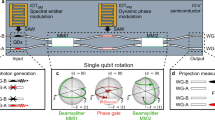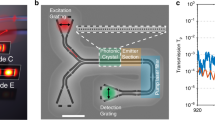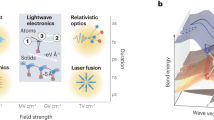Abstract
The formation of a coupled state among on-chip, photonic nanostructures at arbitrary positions as well as its dynamic control are important in the realization of next-generation photonic circuits with elevated functionality such as stopping/slowing of light and quantum information processing. Here, we demonstrate that strong coupling and its dynamic control can be realized for distant, ultrahigh-Q photonic nanocavities. We use a pair of nanocavities with Q-factors exceeding 400,000, connected indirectly by a waveguide with a modified density of states. Surprisingly, even though the distance between the nanocavities exceeds 100 wavelengths, we clearly observe Rabi oscillation, indicating their strong coupling. This oscillation exchanges photons between the nanocavities with a period of 54 ps while concentrating them in the nanocavities, not in the waveguide. In addition, by dynamically controlling the properties of either nanocavity, this exchange of photons can be stopped on demand, freezing the photon state.
This is a preview of subscription content, access via your institution
Access options
Subscribe to this journal
Receive 12 print issues and online access
$209.00 per year
only $17.42 per issue
Buy this article
- Purchase on Springer Link
- Instant access to full article PDF
Prices may be subject to local taxes which are calculated during checkout






Similar content being viewed by others
References
Noda, S., Chutinan, A. & Imada, M. Trapping and emission of photons by a single defect in a photonic bandgap structure. Nature 407, 608–610 (2000).
Akahane, Y., Asano, T., Song, B. S. & Noda, S. High-Q photonic nanocavity in a two-dimensional photonic crystal. Nature 425, 944–947 (2003).
Song, B. S., Noda, S., Asano, T. & Akahane, Y. Ultra-high-Q photonic double-heterostructure nanocavity. Nature Mater. 4, 207–210 (2005).
Kuramochi, E. et al. Ultrahigh-Q photonic crystal nanocavities realized by the local width modulation of a line defect. Appl. Phys. Lett. 88, 041112 (2006).
Tanaka, Y. et al. Dynamic control of the Q factor in a photonic crystal nanocavity. Nature Mater. 6, 862–865 (2007).
Yanik, M. F. & Fan, S. Stopping light all optically. Phys. Rev. Lett. 92, 83901 (2004).
Xu, Q., Dong, P. & Lipson, M. Breaking the delay-bandwidth limit in a photonic structure. Nature Phys. 3, 406–410 (2007).
Yoshie, T. et al. Vacuum Rabi splitting with a single quantum dot in a photonic crystal nanocavity. Nature 432, 200–203 (2004).
Hennessy, K. et al. Quantum nature of a strongly-coupled single quantum dot–cavity system. Nature 445, 896–899 (2007).
Fushman, I. et al. Controlled phase shifts with a single quantum dot. Science 9, 769–772 (2008).
Khitrova, G., Gibbs, H. M., Kira, M., Koch, S. W. & Scherer, A. Vacuum Rabi splitting in semiconductors. Nature Phys. 2, 81–90 (2006).
Noda, S., Fujita, M. & Asano, T. Spontaneous-emission control by photonic crystals and nanocavities. Nature Photon. 1, 449–458 (2007).
Xia, F., Sekaric, L. & Vlasov, Y. Ultracompact optical buffers on a silicon chip. Nature Photon. 1, 65–71 (2007).
Krauss, T. Slow light in photonic crystal waveguides. J. Phys. D 40, 2666–2670 (2007).
Baba, T. Slow light in photonic crystals. Nature Photon. 2, 465–473 (2008).
Notomi, M., Kuramochi, E. & Tanabe, T. Large-scale arrays of ultrahigh-Q coupled nanocavities. Nature Photon. 2, 741–747 (2008).
Eichenfield, M., Camacho, R., Chan, J., Vahala, K. J. & Painter, O. A picogram- and nanometre-scale photonic-crystal optomechanical cavity. Nature 459, 550–555 (2009).
Notomi, M., Taniyama, H., Mitsugi, S. & Kuramochi, E. Optomechanical wavelength and energy conversion in high-Q double-layer cavities of photonic crystal slabs. Phys. Rev. Lett. 97, 023903 (2006).
Yang, X., Yu, M., Kwong, D.-L. & Wong, C. W. All-optical analog to electromagnetically induced transparency in multiple coupled photonic crystal cavities. Phys. Rev. Lett. 102, 173902 (2009).
Pan, J. et al. Experimental demonstration of an all-optical analogue to the superradiance effect in an on-chip photonic crystal resonator system. Phys. Rev. B 81, 041101 (2010).
Takahashi, Y. et al. Design and demonstration of high-Q photonic heterostructure nanocavities suitable for integration. Opt. Express 17, 18093–18102 (2009).
Lee, H. S. et al. Local tuning of photonic crystal nanocavity modes by laser-assisted oxidation. Appl. Phys. Lett. 95, 191109 (2009).
Song, B. S., Asano, T., Akahane, Y. & Noda, S. Role of interfaces in heterophotonic crystals for manipulation of photons. Phys. Rev. B 71, 195101 (2005).
Upham, J., Tanaka, Y., Kawamoto, Y., Sato, Y., Nakamura, T., Song, B. S., Asano, T. & Noda, S. Time-resolved catch and release of an optical pulse from a dynamic photonic crystal nanocavity. Opt. Exp. 19, 23377–23385 (2011).
Upham, J., Tanaka, Y., Asano, T. & Noda, S. On-the-fly wavelength conversion of photons by dynamic control of photonic waveguides. Appl. Phys. Exp. 3, 062001 (2010).
Preble, S. F., Xu, Q. & Lipson, M. Changing the colour of light in a silicon resonator. Nature Photon. 1, 293–296 (2007).
Yamaguchi, M., Asano, T., Sato, S. & Noda, S. Photonic quantum computation with waveguide-linked optical cavities and quantum dots. Preprint at arXiv:1101.3508v1 (2011).
Hagino, H., Takahashi, Y., Tanaka, Y., Asano, T. & Noda S. Effects of fluctuation in air hole radii and positions on optical characteristics in photonic crystal heterostructure nanocavities. Phys. Rev. B 79, 085112 (2009).
Acknowledgements
The authors thank M. Yamaguchi and Y. Taguchi for fruitful discussions and helpful advice. This work was partly supported by Grants-in-Aid for Scientific Research of the Ministry of Education, Culture, Sports, Science and Technology of Japan, FIRST programme, and the Global Centre of Excellence for Education and Research on Photonics and Electronics Science and Engineering of Kyoto University, Japan. Y.S. acknowledges support from a Research Fellowship of the Japan Society for the Promotion of Science.
Author information
Authors and Affiliations
Contributions
S.N. planned and organized the entire project. Y.S. revealed the design conditions necessary to achieve strong coupling between distant nanocavities through a waveguide, based on analyses performed with Y.T. and T.A. The photonic crystal structures were fabricated by Y.S. together with Y.T. Measurements were performed by Y.S. together with J.U. and T.A. All authors discussed the results and wrote the manuscript.
Supplementary information
Supplementary information
Supplementary information (PDF 519 kb)
Rights and permissions
About this article
Cite this article
Sato, Y., Tanaka, Y., Upham, J. et al. Strong coupling between distant photonic nanocavities and its dynamic control. Nature Photon 6, 56–61 (2012). https://doi.org/10.1038/nphoton.2011.286
Received:
Accepted:
Published:
Issue Date:
DOI: https://doi.org/10.1038/nphoton.2011.286
This article is cited by
-
Non-Hermitian control between absorption and transparency in perfect zero-reflection magnonics
Nature Communications (2023)
-
Self-evolving photonic crystals for ultrafast photonics
Nature Communications (2023)
-
Electrically controlled on-demand photon transfer between high-Q photonic crystal nanocavities on a silicon chip
Nature Photonics (2022)
-
Quantum superposition demonstrated higher-order topological bound states in the continuum
Light: Science & Applications (2021)
-
Loss-induced nonreciprocity
Light: Science & Applications (2021)



